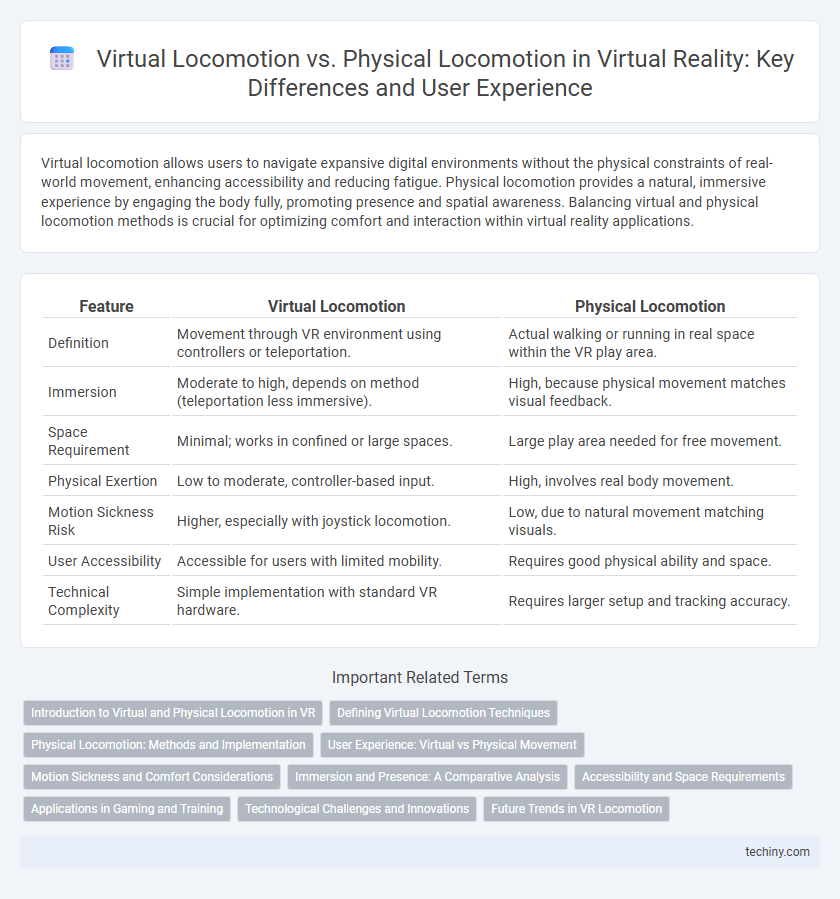Virtual locomotion allows users to navigate expansive digital environments without the physical constraints of real-world movement, enhancing accessibility and reducing fatigue. Physical locomotion provides a natural, immersive experience by engaging the body fully, promoting presence and spatial awareness. Balancing virtual and physical locomotion methods is crucial for optimizing comfort and interaction within virtual reality applications.
Table of Comparison
| Feature | Virtual Locomotion | Physical Locomotion |
|---|---|---|
| Definition | Movement through VR environment using controllers or teleportation. | Actual walking or running in real space within the VR play area. |
| Immersion | Moderate to high, depends on method (teleportation less immersive). | High, because physical movement matches visual feedback. |
| Space Requirement | Minimal; works in confined or large spaces. | Large play area needed for free movement. |
| Physical Exertion | Low to moderate, controller-based input. | High, involves real body movement. |
| Motion Sickness Risk | Higher, especially with joystick locomotion. | Low, due to natural movement matching visuals. |
| User Accessibility | Accessible for users with limited mobility. | Requires good physical ability and space. |
| Technical Complexity | Simple implementation with standard VR hardware. | Requires larger setup and tracking accuracy. |
Introduction to Virtual and Physical Locomotion in VR
Virtual locomotion in VR enables users to navigate expansive digital environments without physical movement, leveraging techniques such as teleportation, joystick movement, and walking-in-place. Physical locomotion involves real-world movements like walking or running, tracked by sensors to replicate motion inside the virtual space, enhancing immersion through natural interaction. Balancing virtual and physical locomotion methods addresses user comfort, space limitations, and motion sickness challenges, optimizing the overall VR experience.
Defining Virtual Locomotion Techniques
Virtual locomotion techniques in virtual reality enable users to navigate digital environments without physical movement, utilizing methods such as teleportation, joystick movement, and gaze-directed walking. These techniques address challenges like motion sickness and limited physical space by simulating movement through controlled inputs rather than actual bodily motion. Understanding the trade-offs between virtual locomotion and physical locomotion is crucial for optimizing user immersion and comfort in VR experiences.
Physical Locomotion: Methods and Implementation
Physical locomotion in virtual reality involves real-world movement methods such as walking, running, and crouching, which are tracked using sensors, treadmills, or motion capture systems. Implementation often requires precise tracking technologies like inertial measurement units (IMUs) and external cameras to ensure accurate positional data and reduce motion sickness. These systems prioritize natural user movement, enhancing immersion and spatial awareness within the virtual environment.
User Experience: Virtual vs Physical Movement
Virtual locomotion methods such as teleportation, joystick movement, and arm-swinging offer diverse solutions to alleviate motion sickness and enhance user comfort in VR environments. Physical locomotion, involving actual walking or treadmills, provides natural proprioceptive feedback and immersive presence but can be limited by physical space and safety concerns. Balancing virtual locomotion's convenience with physical movement's realism is essential to optimize user experience and minimize disorientation in virtual reality applications.
Motion Sickness and Comfort Considerations
Virtual locomotion in virtual reality often triggers motion sickness due to sensory conflicts between visual movement cues and the lack of corresponding physical body motion, impacting user comfort and immersion. Physical locomotion, involving actual body movement within a tracked space, minimizes sensory mismatch and significantly reduces motion sickness symptoms, enhancing overall comfort during extended VR sessions. Choosing locomotion methods that align with natural proprioceptive feedback is essential for optimizing user experience and minimizing discomfort in VR applications.
Immersion and Presence: A Comparative Analysis
Virtual locomotion techniques in virtual reality, such as teleportation and joystick movement, often enhance immersion by enabling rapid exploration of expansive environments, while physical locomotion--walking or room-scale movements--offers a stronger sense of presence by engaging natural proprioceptive feedback. Studies indicate that physical locomotion reduces cybersickness and increases spatial awareness, fostering a deeper connection to the virtual environment. Optimizing virtual locomotion methods involves balancing user comfort and immersion to maximize presence and overall VR experience.
Accessibility and Space Requirements
Virtual locomotion techniques in VR reduce spatial requirements by enabling user movement without the need for expansive physical environments, enhancing accessibility for individuals with limited space or mobility. Physical locomotion demands larger play areas and may not be feasible for users with disabilities or confined living conditions. By incorporating teleportation or joystick-based movement, VR experiences become more inclusive and adaptable to diverse user needs and spatial constraints.
Applications in Gaming and Training
Virtual locomotion in gaming offers players seamless navigation through expansive digital environments without physical movement, enhancing immersion and reducing space constraints. Physical locomotion, by incorporating real body movements, improves training simulations by promoting muscle memory and spatial awareness critical for realistic practice scenarios. Comparing both methods highlights virtual locomotion's efficiency for extended gameplay and physical locomotion's effectiveness in skill acquisition during professional training.
Technological Challenges and Innovations
Virtual locomotion in VR faces technological challenges such as motion sickness, latency, and limited spatial tracking accuracy, which contrast with the natural proprioceptive feedback of physical locomotion. Innovations like advanced inertial measurement units (IMUs), predictive algorithms, and room-scale tracking systems have significantly improved user immersion by reducing latency and increasing positional precision. Emerging solutions such as haptic feedback suits and omnidirectional treadmills aim to bridge the sensory gap between virtual and physical movement, enhancing overall user experience and interaction fidelity.
Future Trends in VR Locomotion
Future trends in VR locomotion emphasize seamless integration between virtual locomotion methods and physical movement to reduce motion sickness and enhance immersion. Technologies like omnidirectional treadmills and advanced haptic feedback systems are set to revolutionize user interaction by enabling natural walking and running within virtual environments. AI-driven adaptive locomotion algorithms will further personalize movement experiences, optimizing comfort and spatial orientation in diverse VR applications.
virtual locomotion vs physical locomotion Infographic

 techiny.com
techiny.com